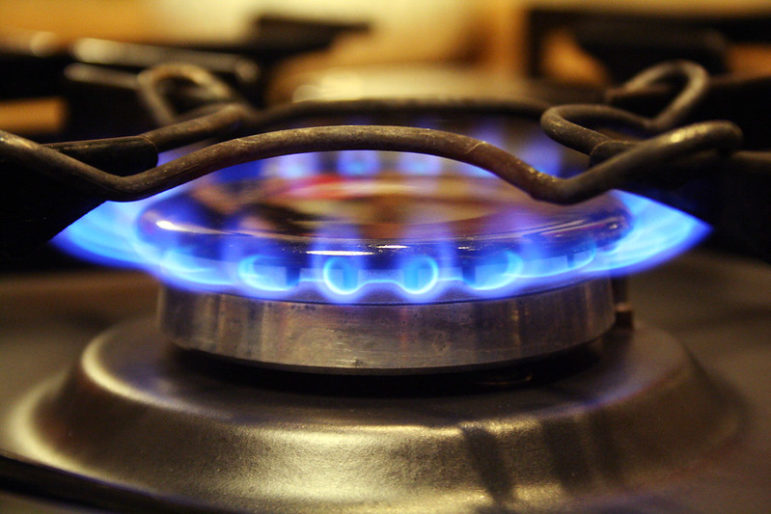
A report released Monday by climate activists raises questions about the rationale for building new natural gas infrastructure in a state that has mandated a dramatic reduction in fossil-fuel use over the next three decades.
The activists’ report comes ahead of a hearing Monday evening in which National Grid will present the findings of a study it released last month. That study projected demand for natural gas over the next 15 years and outlined ways to cover what the utility says will be a supply shortage—with the construction of a new pipeline as a top option.
Monday’s meeting is one in a series that, along with National Grid’s study, were required under a settlement the utility reached last fall with the Cuomo administration, which had threatened to suspend National Grid’s license over the utility’s self-imposed moratorium on new gas connections.
That dispute followed the state’s rejection last May of a permit for National Grid’s Northeast Supply Enhancement (NESE) project—a 24-mile underwater pipeline running from New Jersey to the Rockaways also known as the Williams Pipeline (Williams is the company that would build and operate it).
The utility has appealed that denial and the Cuomo administration will have to decide by this May whether to again reject the project, which the Trump administration has discussed subverting state environmental authority in order to facilitate, or accept the construction of multimillion-dollar fossil-fuel infrastructure that will last for decades beyond the legal deadline for New York to move to other fuel sources.
A state law passed last year requires 70 percent of New York’s electricity to come from renewable sources by 2030, rising to 100 percent by 2040, and imposes a mandate to reduce greenhouse-gas emissions 85 percent and adopt carbon-offsets for the remaining 15 percent of emissions so that the state is carbon neutral by the year 2050.
A problem at the peaks
In its study, National Grid said gas usage during peak periods—the coldest days of the year—has been growing an average of 2.4 percent per year, straining the utility’s ability to provide consistent supplies.
The utility predicts that growth will slow to 1.8 percent a year between now and 2035 based on current trends. It could grow as slowly as 0.8 percent a year when planned conservation programs kick in. Even at that modest pace of demand growth, the utility still foresees “a supply vs. demand gap that starts by the winter of 2021/22 and continues to grow until at least 2032/33.”
The National Grid study outlines several options that could be combined in different ways to close the gap: large-scale infrastructure like pipelines to provide long-term capacity, smaller infrastructure investments targeted to cover peak periods, and efficiency programs meant to reduce demand or shift it from gas to the electrical grid.
While National Grid’s study does not explicitly name a favored approach, it clearly indicates that large infrastructure like NESE is what’s needed if the system is to avoid having “zero short-term contingency available” and possibly having to “restrict new gas customer connections.”
National Grid says it is committed to getting New York to its clean-energy goals. “We are fully cognizant of the changing role of utilities, and the desire to include non-pipeline alternatives as part of the pathway to a sustainable energy future,” its study reads.
Questioning the diagnosis and the prescription
The report released Monday was prepared by the consultancy Energy Futures Group for the climate-change advocacy organization 350.org and 350Brooklyn. It questions the premise from which National Grid starts: that there is or is likely to be a shortage of natural gas in the New York City region.
According to the Energy Futures Group report, the federal Energy Information Administration (EIA) predicts a significantly slower rate of growth in natural gas consumption nationwide than National Grid estimates for the metro region: 1.6 percent over the next 10 years, as opposed to the 11 percent growth over the decade that National Grid projects. “An adjustment based on EIA’s data would reduce National Grid’s projection of future energy needs by nearly 85 percent,” the report contends.
However, the Energy Futures Group says it’s hard to say exactly how valid National Grid’s projections are because the utility has said little about how it generated them. “It is impossible to analyze and verify the validity of National Grid’s final forecasted demand,” the report concludes.
Whatever the projection for gas demand, Energy Futures Group says “non-pipeline alternatives such as energy efficiency, demand response, flexible load management, strategic electrification through cold climate air source heat pumps, and sealing gas leaks in existing pipelines” would likely cover 88 percent of the forecasted needs. That would require National Grid to reduce leaks in its system by 60 percent, convert80,000 customers to heat pumps by 2025 and get 20 percent of customers to commit to “demand response” programs that reduce gas usage during peak times.
In general, the advocates and National Grid agree on the methods for reducing gas demand, but differ on estimates of how much impact any of those efforts will have—with advocates being more optimistic.
If natural growth in gas demand is slower than National Grid predicts and the non-pipeline options cover more of that new demand than the utility has estimated, it’s possible that the region could avoid supply shortages without building a new pipeline. And, according to the advocates, that would make better financial and environmental sense.
“Investment in new gas infrastructure with a decades-long lifespan can lead to stranded costs, under-utilized assets, and emissions that are incompatible with climate targets,” the report reads. “Ratepayers may end up bearing undue costs, and investment in new pipeline capacity may discourage investments in energy efficiency, peak demand reduction programs, electrification of space heating and decarbonization of the grid, all of which are critical to a sustainable energy future.”
Eyes on the city
NESE is not the only new natural gas infrastructure the utility is proposing. In its most recent application to state regulators for a rate hike, National Grid also discusses a new pipeline loop and compressed natural gas filing station on Staten Island, a new portable facility for liquid natural gas at its plant in Greenpoint, and the need for gas-injection infrastructure at two unspecified sites.
National Grid’s rate case also notes a plan to truck liquid natural gas by truck through New York City to the Greenpoint plant in the event of a shortage—but says that initiative has been delayed because the de Blasio administration has yet to approve it.
Advocates are scrutinizing Mayor de Blasio’s approach to decisions about gas infrastructure as much as they are Cuomo’s. The mayor in his annual State of the City speech last month promised a ban on new pipelines. But it is unclear how the administration will approach projects whose stated goal is not to create new gas capacity, but rather to improve the safety and reliability of the existing system—a rationale frequently cited by utilities.
Advocates maintain that shoring up the existing system could be just as problematic as building new capacity, because both approaches postpone the end-date for fossil-fuel use.
Meetings—not hearings—loom
The meeting on Monday is scheduled for 5-8 p.m. at the Hicksville Community Center, 28 W. Carl Street, in Hicksville, N.Y. National Grid has other public meetings scheduled for later this week and month:
• March 12, 6-8 p.m. at the YMCA, 89-25 Parsons Blvd., Jamaica, Queens
• March 23, 6-8 p.m. at the Brentwood Public Library, 34 Second Ave., Brentwood, N.Y.
• March 24, 6-8 p.m. at Brooklyn Borough Hall, 209 Joralemon St., Brooklyn, N.Y.
• March 25, 6-8 p.m. at Kingsborough Community College, 2001 Oriental Blvd, Brooklyn.
• March 31, 6-8 p.m. at the Riverhead Fire Department, 540 Roanoke, Riverhead, N.Y.
Advocates had criticized the planned meetings, which are being billed as “information sessions,” as emphasizing the utility’s message over the public’s feedback. But the state’s Public Service Commission clarified in a Friday letter that oral as well as written comments will be accepted at the meetings.









